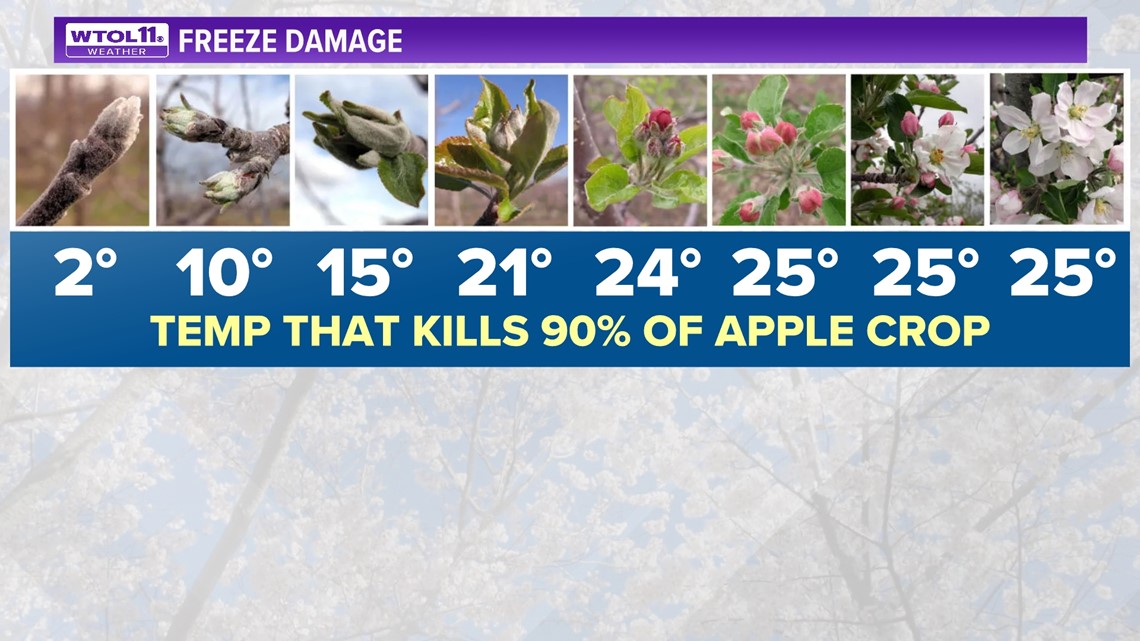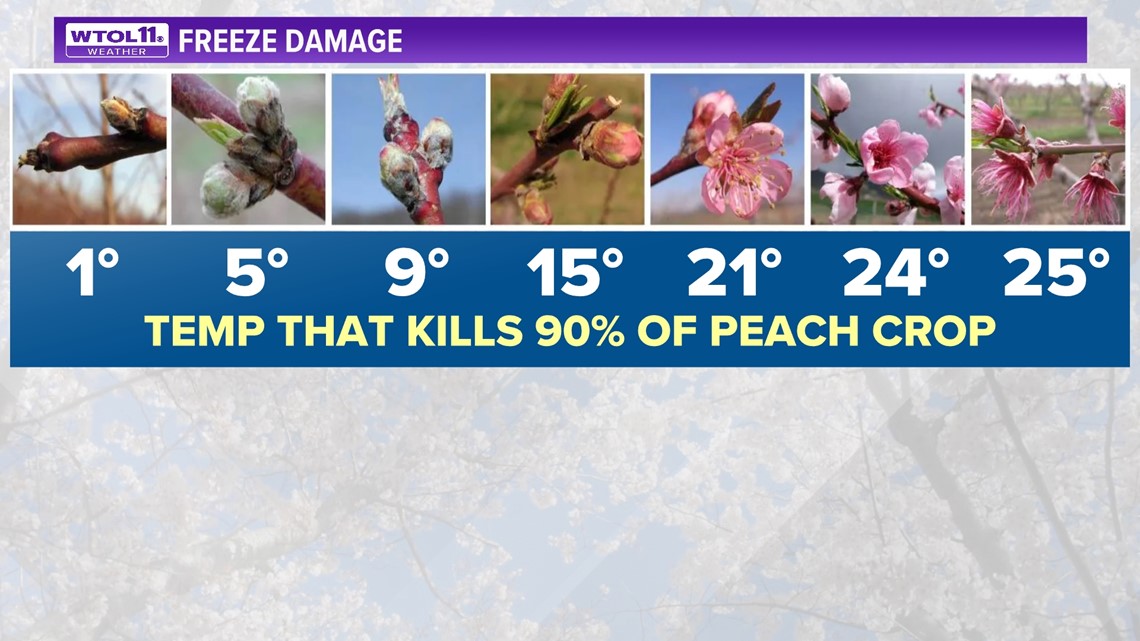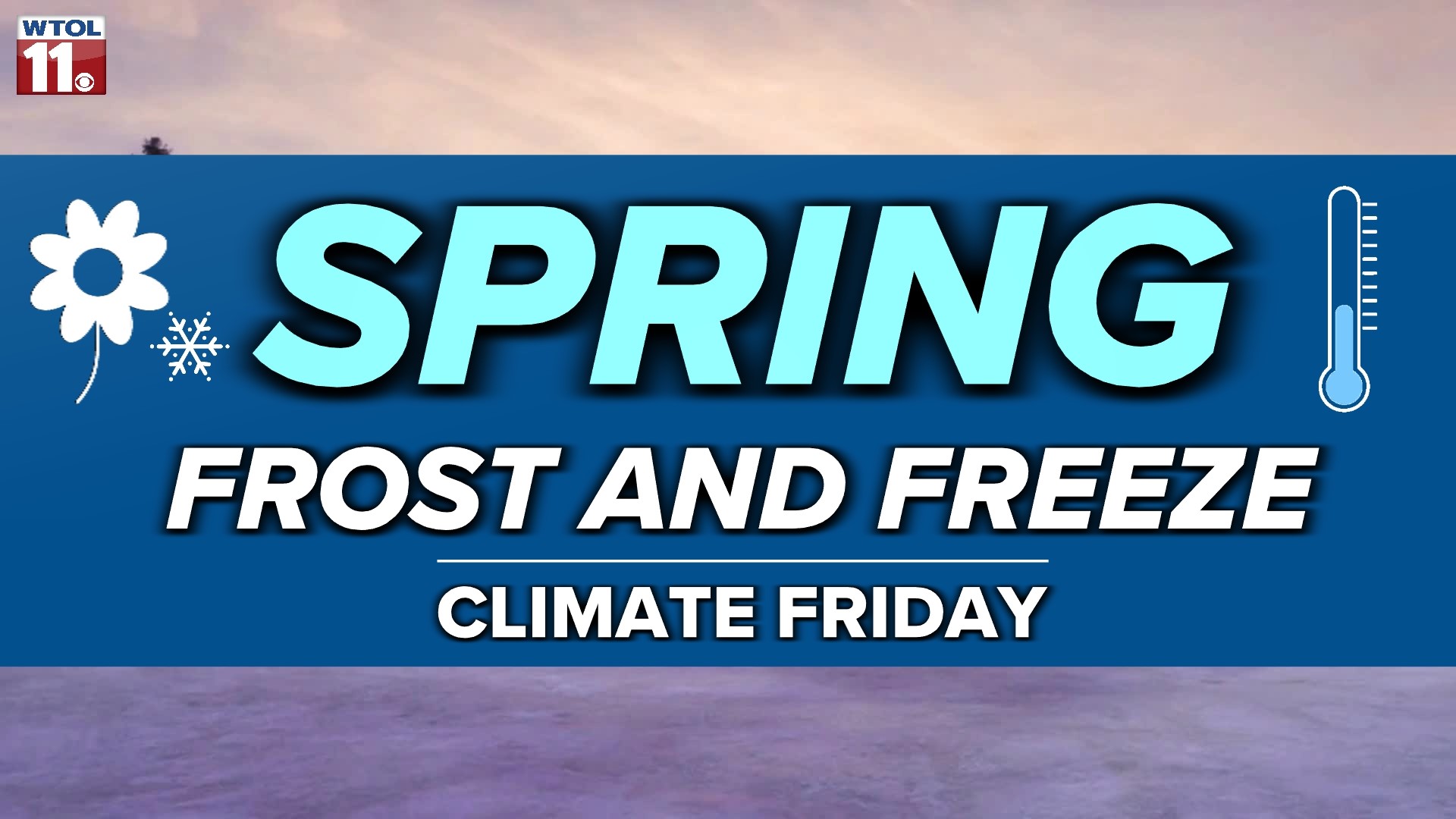TOLEDO, Ohio — After last week's taste of summer, much colder conditions have arrived for late-April.
This week featured a spring frost with temperatures in the upper 20s to low 30s. How is climate change impacting our likelihood of spring frost and freeze, and what do these erratic temperatures mean for area farmers? We have answers those questions in this week's edition of Climate Friday.
Wednesday morning delivered frosty conditions for most of northwest Ohio and southeast Michigan. With an overnight low of 32 degrees at Toledo Express Airport, Wednesday morning brought widespread frost and freeze to the region. Some spots in southeast Michigan, such as Hillsdale, dipped down as low as 26.
Despite the April chill, these temperatures fell far below the record low of 22 degrees. April frost and freeze are fairly common, and the conventional wisdom to wait until after Mother's Day to plant flowers is sound in evidence.
In a normal year, our last freeze of the year, defined as a 32-degree temperature reading, occurs on April 26. Our final frost (36 degrees) of spring doesn't typically happen until May 8. Gardens and crops remain vulnerable to the elements in April and May as frost and freeze commonly occur.
So how can a spring freeze impact spring gardens and area farmers? In a weather whiplash known as "false spring," a hard freeze that occurs after the spring bloom can damage or even kill an entire crop.
While plants are highly resilient to freezing temperatures while protected during the winter months, they become more vulnerable to temperature extremes after the spring bloom. This graph shows the temperature required to kill 90% of a fruit crop after budding.


While the exact temperature requirement varies between plant types, colder is worse for area farmers. Frosty conditions in the 30s are rarely detrimental to fruit crops. Temperatures around 28 degrees will kill around 10% of a fruit crop.
While impactful, these temperatures in the upper 20s will still spare the vast majority of a crop. Temperatures just a few degrees colder around 25 often kill a whopping 90% of the entire crop.
Additionally, the vulnerability of a fruit crop depends highly on how far along the spring bloom has progressed. As you can see from this chart, cold weather becomes increasingly damaging once flower buds begin to burst open into bloom.


A spring freeze after a full bloom in late-April and May can mean trouble for area farmers. In 2012, erratic spring temperature swings caused a devastating $500 million in losses to Michigan fruit farmers. Apple crops were wiped out due to the hard freeze following a spring bloom.
Ohio farmers have also felt the same financial toll of a late spring freeze. One year of lost harvest can financially ruin a small farm, and even a partial loss can put local farmers in a big hole.
Even though this week featured sub-freezing temperatures, overnight lows generally remained well above the hard freeze threshold of 26 required to cause total devastation to fruit crops.
How is climate change affecting the spring bloom and the likelihood of a late freeze? Overall, the growing season is getting longer due to global warming. The number of days without a frost or freeze is increasing due to a rise in global temperatures.
Across the entire United States, the number of annual frost-free days has increased drastically. Across the Great Lakes region, that number has increased by nine days annually in the last half century. Other parts of the country, including the southwest, have seen an uptick of 19 more days without a frost or freeze.
This elongation of the growing season has shifted the spring bloom in many plant species. One study in Europe found that due to climate change, the spring bloom has shifted 4.3 days earlier per decade. This trend represents a change in nearly a month over the past half century.
An earlier spring bloom makes plants more vulnerable to late-season frost and freeze. A premature February or March bloom is often followed by a spring freeze, and the sooner buds open on trees, the more likely a damaging freeze may become.
Some fruit farmers have employed mitigation strategies to reduce the impacts of a potential freeze. This diagram shows a wind machine employed by apple farmers to distribute milder air throughout the orchards.


Cold air often pools near the Earth's surface, and on a frigid night, this phenomenon can spell trouble for a fruit crop. Wind machines circulate warmer air aloft, blowing a milder breeze at the ground level and elevating surface temperatures to reduce the risk associated with a spring freeze.
While wind machines are not foolproof, they represent an effective way to prepare for a spring freeze and mitigate potential impacts. An ounce of prevention is worth a pound of cure.
The chilly spring weather will likely continue through the end of April, threatening area farms and gardens with frosty conditions. The WTOL 11 weather team will be the first to let you know about upcoming weather conditions that may affect spring agriculture.
RELATED VIDEO

